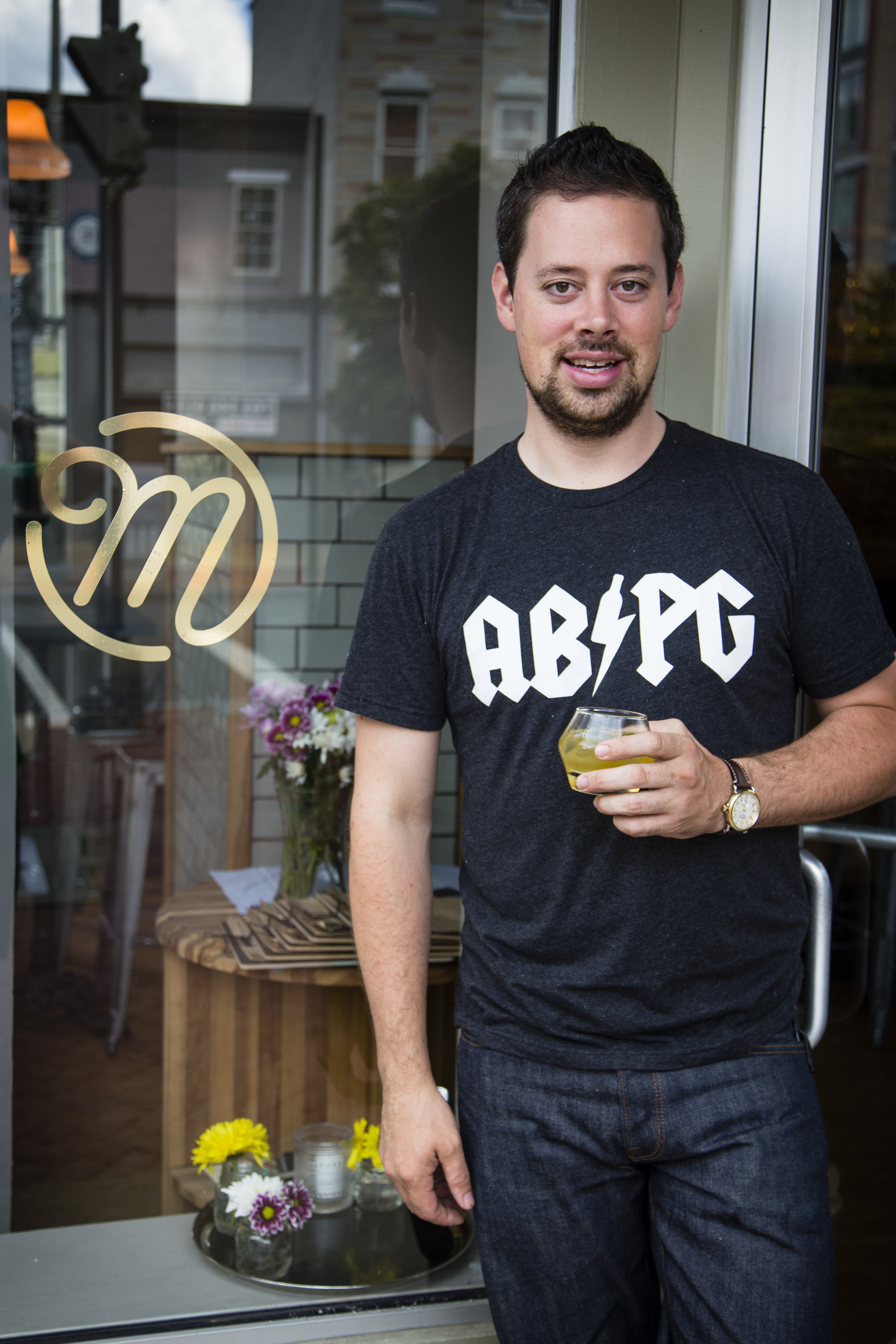Looks can be deceiving. Especially when Brent Kroll mixes a cocktail. He’s better known as one of DC’s top wine sommeliers, who most recently went all in on his first business venture, Maxwell, a corner wine bar that’s come to Shaw.
Sure, he can pick out the perfect Pinot Noir from the Loire Valley or surprise you with a refreshingly dry and crisp Riesling, but it’s his cocktail game that’s truly winning people over. In a tiny corner of Maxwell’s menu are four rotating drinks, seasonal cocktails with no-fuss rules.
“We’re not trying to be craft cocktails,” Kroll says. “Actually, we are the anti-speakeasy because each of our cocktails is pre-batched and can be made in seconds.”
That’s music to an at-home bartender’s ears, or those who might be entertaining several thirsty guests at a party. If you’re looking to experiment and add new flavors to your bar routine while keeping it straightforward and simple, then give Kroll’s peanut-infused rum cocktail—The Samuelsson—a try.
“It’s kind of like a salted-caramel surprise,” he says. “With the dill you get a lot of that flavor on the nose. And in the warmer fall months you can still pick it fresh from the herb garden.”
Peanuts are an unusual choice for a cocktail, but perfect for fall. They are harvested in September and October when the leaves turn yellow. Peanuts also pair nicely with one of Kroll’s top picks for rum: Smith & Cross Navy Strength Rum, bottled in London but produced in Jamaica. It’s a medium, blended rum with a subtle butterscotch flavor.
When fresh Virginia peanuts are added and infused for several days, their salt and fat help to create a much more complex flavor. It’s the oiliness and fat from the peanuts that stands out the most.
On each sip, you get a buttery savoriness with only a slight hint of salt. Kroll combines his infused rum with an equal-parts mix of simple syrup and lemon juice. That cuts through the peanut flavor with a bright acidic burst of summertime flavor.
Think of this drink as your seasonal sipper moving from September’s summerlike days to November’s colder, dark nights. “It perfectly captures that fall feeling,” Kroll says. “And regardless of the season, I always have a thing for savory cocktails—this one is definitely my favorite.”
Look for it on his menu this fall at Maxwell for $11 a glass. Part of the credit also goes to celebrity chef Marcus Samuelsson, owner of bar and restaurant Marcus at the MGM National Harbor Casino in Oxon Hill, MD.
“It’s named after a trip I took to New York City, where I was scouting some wine bars,” Kroll says. “I stopped at his restaurant [Red Rooster] and had a chicken dish using nuts and dill. Right then and there, I wanted to incorporate the dish into a drink, so I named it after Marcus to pay homage.”
His cocktails may be easy to make, but they do require a bit of prep work. For The Samuelsson, find Smith & Cross Navy Strength Rum at many specialty liquor shops, including Schneider’s of Capitol Hill. If you’re in a pinch, El Dorado 5-Year Aged Rum does the trick too. Just avoid white or dark-aged rums, Kroll says.
Any type of Virginia peanut will do. Just be sure to leave the skin on and roast about a half cup with olive oil and sea salt in a saucepan. For the infusion, add the peanuts to the rum and seal in a Mason jar for at least three days. Kroll recommends shaking the bottle once per day to ensure the proper infusion.
“You can tell when the peanuts infuse because they’ll start to reduce a little, and if you bite into one, it’s devoid of all flavor,” he says.
On the last day, Kroll adds dill to the infusion, then waits one more day before straining the spirit to separate out the peanuts or dill. Closer to his bartending shift, Kroll pre-batches a one-to-one mix of simple syrup and fresh-squeezed lemon juice. The bright citrus gives way to a salty rum finish—something only a sommelier’s palate could master.
“Wine definitely teaches you about aging, as well as the balance of flavors,” Kroll says. “When you’re tasting wine, it’s the same as tasting cocktails. You have this math in your head, where you say, ‘How do I combine or pair something that’s slightly salty, acidic, sweet and savory?’”
The Samuelsson
Ingredients:
- Smith & Cross Navy Strength Rum or El Dorado 5-Year Aged Rum
- Lemon juice
- Dill (stem on)
- Virginia peanuts (skin on)
- Olive oil
- Sea salt
- Sugar
To make the infused rum:
Allow at least 3 days for the rum to infuse with the peanuts. Kroll typically infuses for a full week. Roast about a half cup of peanuts with olive oil and sea salt in a medium saucepan on high heat for about 2 to 3 minutes.
Place the roasted peanuts in a Mason jar, add the rum and tightly seal the lid. Allow the mix to sit for up to a week, remembering to shake the infusion once per day. On the final day, add 3 to 4 sprigs of fresh dill with the stem on; let it sit for 24 hours. To batch, use a mesh strainer, separating out the peanuts and dill. Pour the rum back in the bottle.
To make the lemon simple syrup mix:
Kroll recommends making lemon simple syrup in small batches to ensure freshness. In a saucepan combine equal parts sugar and water, stir and bring to a boil. Then, allow the mix to cool. In a squeeze bottle add equal parts lemon juice and simple syrup. Refrigerate and keep for up to 1 week.
To make The Samuelsson:
Partially fill a cocktail glass with ice cubes. Pour equal parts infused rum and lemon simple syrup, either 1 or 2 shots each. Garnish with a sprig of dill.







